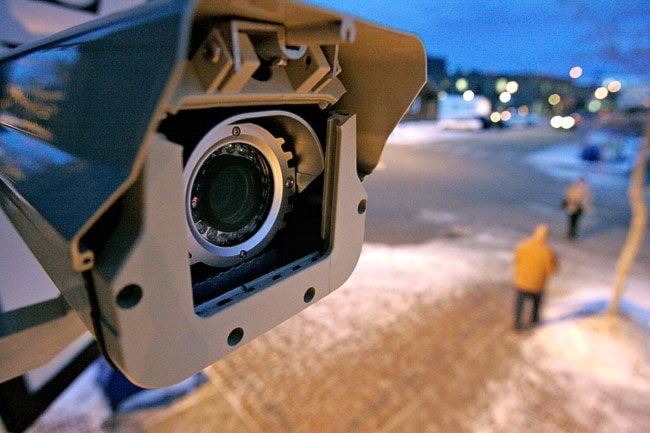The city will soon have a closer watch on you than you think.
Last month the city announced it will spend $60,000 to install 18 cameras at utility stations around Whitehorse beginning in the new year.
It is the first stage of an anti-vandalism plan that will eventually see upwards of 60 cameras installed around the city, which will potentially include locations in high-traffic public areas like Shipyards Park.
The initiative is intended to curb graffiti and damage to the city’s pump houses and lift stations.
Most of these buildings are in remote locations such as the McIntyre pumphouse, which is tucked away between the Yukon College and the Kopper King and is only accessible by a dirt road.
But there are some utility stations right in the middle of downtown Whitehorse, which may have security cameras installed on them. This includes a sewage lift station in the middle of Shipyards Park, a lift station at the skateboard park near the S.S. Klondike and a utility building on Second Avenue near Main Street.
The cameras will be connected by a network of fibre-optic cables feeding into the Two Mile Hill booster station and the footage will be monitored only after an act of crime has taken place, said city manager Dennis Shewfelt.
“The cameras will only be pointed at doorways,” he added.
“We won’t be looking to watch you drink your coffee at Tim Hortons.”
But a feasibility camera study conducted two years ago found that many of the utility stations will require more than one camera and that often a camera mounted “as high as a telephone pole” will be required to “overlook the bigger picture,” in case the camera lower to the ground gets vandalized, said utility stations supervisor, Ray Osborne.
“Some stations may even require three cameras,” he said.
In 2008, the city put aside $50,000 in its capital budget for security cameras. But the camera installation didn’t happen last year and in March the money was rolled over into the 2009 budget along with $7.9 million in funding for other uncompleted projects.
The decision to install the cameras was never discussed by city council aside from a brief mention at a May 11 council meeting in which councillor Dave Stockdale announced administration had undertaken a camera study “in-house” to “co-ordinate the installation of security cameras at city properties and facilities.”
The item was considered “for-information only” and was part of an overall update from the administrative services committee Stockdale co-chaired at the time.
It wouldn’t have been necessary to have a public discussion about the installation of security cameras at a regular council meeting, said Stockdale recently.
“It was not a decision of council, it was a decision of management,” he said.
“But I’m sure council would have endorsed it anyway.”
And because the cameras were budgeted at $50,000, the maximum amount administrators are allowed to spend without council approval, technically the decision didn’t need to go through council, he added.
Council intends to add cameras to the network in a piecemeal fashion, slowly adding more each year, said Osborne.
Osborne couldn’t say where the first 18 cameras would be installed since he won’t be giving input into which city stations should receive cameras.
“The locations will be made by management based on the (security camera) consultants’ recommendations,” he said.
When asked whether the cameras would compromise people’s privacy, Stockdale said he had initially had “the same thoughts about invasion of privacy,” but later changed his mind.
“The cameras will only focus on buildings, they won’t scan the environment,” he said.
“It’s a deterrent, not an invasive type of privacy.”
But if there are to be cameras mounted on supports as tall as telephone poles, then areas beyond the parameters of the building may also be captured on tape.
A camera network is often seen as a “quick fix” for city governments dealing with crime, said Carleton University professor Josh Greenberg who has conducted extensive research into surveillance camera systems that have been implemented in cities throughout Canada.
Cameras are often seen as a fast solution even though “there’s fairly convincing evidence that cameras in public are not effective in reducing crime,” he said.
Where cameras are useful in heading off crime is when they are installed in enclosed environments, like a parking garage, and when cameras are used in conjunction with other initiatives like increased lighting and signage.
It also helps when there is buy-in from the public, he added.
“One of key things we found in our research is that across Canada there tends to be a very low level of open, public discussion (about the introduction of cameras),” said Greenberg
“There is a very, very rare occurrence of councillors or other interests that will engage the public on what might the introduction of cameras to do resolve the problem of crime, ask whether it is desirable and what are the possible consequences of going down that road.”
Cameras are also not cost-neutral technologies, Greenberg pointed out.
“These days they are less expensive to purchase and install, but they still require maintenance”
In the rush to curb crime, what is often overlooked is that cameras can ultimately alter the social fabric of a city, he said.
Contact Vivian Belik at
vivianb@yukon-news.com
